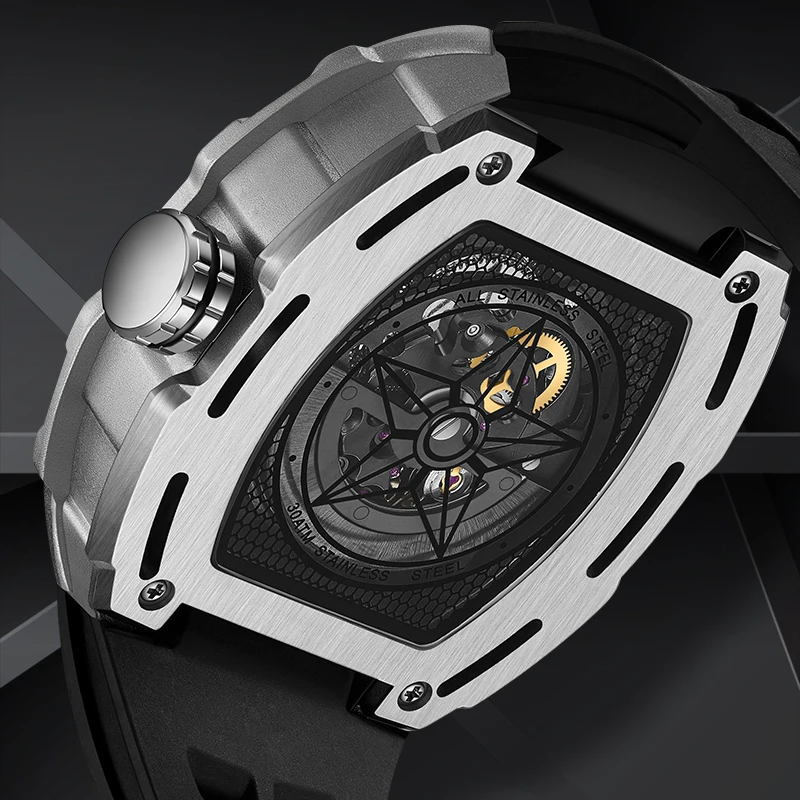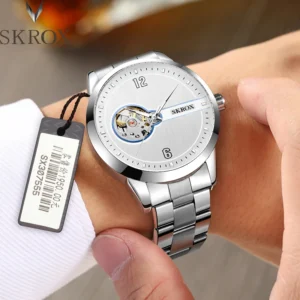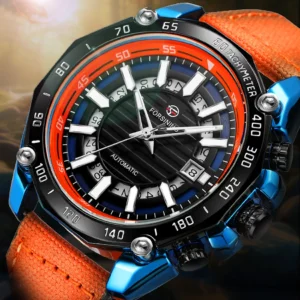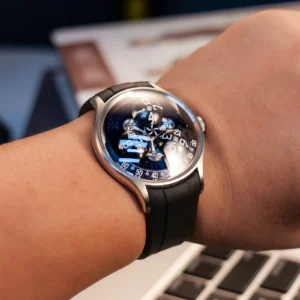Introduction: First Glance at Watchmaking Artistry
Open heart and skeleton watches represent two distinct approaches to celebrating the beauty of mechanical watchmaking. At their core, these styles differ in how much of the movement they reveal: open heart watches feature a small window showcasing the balance wheel—the “heartbeat” of the timepiece—while skeleton watches remove most non-essential material to display the entire mechanical system in all its glory.
Understanding these differences matters tremendously when selecting a timepiece that aligns with your personal style and practical needs. Both styles honor the centuries-old tradition of mechanical watchmaking, but they do so with dramatically different visual impacts and wearing experiences.
In this guide, we’ll explore the distinctive characteristics of each style, the craftsmanship involved in their creation, and how to determine which might better suit your preferences. The historical development of watchmaking techniques has led to these fascinating mechanical displays that transform timekeeping into wearable art—a philosophy we deeply appreciate at Sharp Aspect.
Open Heart vs. Skeleton Watches: A Side-by-Side Comparison
| Feature | Open Heart Watches | Skeleton Watches |
|---|---|---|
| Movement Visibility | Limited aperture showing balance wheel | Extensive view of entire movement |
| Design Approach | Selective revelation | Comprehensive exposure |
| Dial Presence | Mostly intact with window | Reduced or completely absent |
| Aesthetics | Subtle elegance with mechanical accent | Bold, complex technical artistry |
| Readability | Generally excellent | Can be challenging |
| Ideal For | Those seeking balance of tradition and mechanical interest | Enthusiasts who prioritize mechanical display over simplicity |
This comparison serves as your reference point as we delve deeper into each style’s unique characteristics. The fundamental difference lies in the extent of the reveal—one offers a glimpse while the other presents a comprehensive view of the movement visibility aspects that make mechanical watches so fascinating.
What Is an Open Heart Watch? The Beating Heart in Focus
An open heart watch features a precisely placed aperture or window on the dial that specifically reveals the balance wheel and escapement—the components that regulate the timekeeping of a mechanical watch. This design gets its name from the rhythmic, pulse-like movement of the balance wheel, which resembles a beating heart.
The Perfect Glimpse
What makes open heart designs special is their restrained approach to mechanical revelation. Rather than exposing everything, they provide a thoughtful glimpse into the most visually dynamic part of the movement. This selective approach maintains the watch’s primary function of clear time-telling while adding a touch of mechanical fascination.
Aesthetic Balance
Open heart watches offer a refined elegance that bridges traditional watchmaking with contemporary design sensibilities. The mostly intact dial provides excellent readability, while the window adds visual interest and movement. The manufacturing process focuses on precision cutting rather than extensive material removal, preserving the structural integrity of the dial and movement plates.
These watches typically appeal to wearers who appreciate subtle sophistication and prefer a watch that offers mechanical interest without sacrificing functionality. Our collection of open heart automatic watches demonstrates how this balanced approach creates timepieces that work beautifully for both everyday wear and special occasions.
What Is a Skeleton Watch? The Art of Complete Revelation
A skeleton watch takes transparency to its ultimate expression by removing all non-essential material from the movement plates, bridges, and sometimes even the dial. This extensive process of material removal—called skeletonization—transforms the watch into a see-through mechanical showcase where nearly every working component becomes visible.
The Skeletonization Process
Creating a skeleton watch is an intricate art form that begins with watchmakers carefully analyzing the movement to determine which metal can be safely removed without compromising structural integrity. After removing this material, each remaining component undergoes meticulous finishing—including polishing, beveling edges, and often engraving or other decorative techniques.
Visual Complexity as Art
The resulting timepiece becomes a mesmerizing display of mechanical complexity, where time-telling shares equal importance with the visual spectacle of the exposed gears, wheels, and springs. The skeletonization process transforms the watch into wearable kinetic art, with every turn of the wrist bringing new angles to appreciate the internal architecture.
This complexity does come with practical considerations—primarily regarding readability. With numerous mechanical elements visible behind or instead of a traditional dial, telling time can require more focused attention. However, for enthusiasts who value the automatic skeleton watches aesthetic, this trade-off is well worth the extraordinary visual experience.
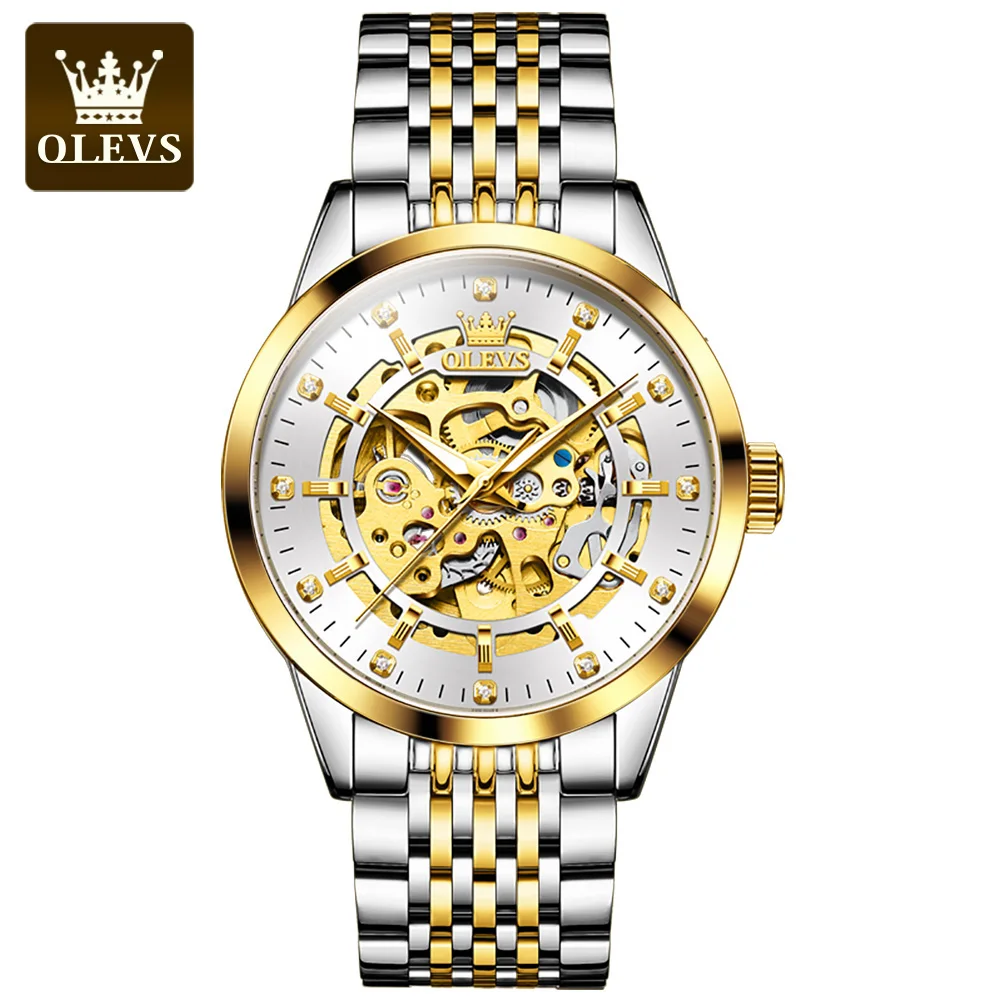
Terminology Clarified: Open Heart, Skeleton, and Openworked
The watchmaking world uses several terms that are important to understand when discussing transparent watch designs. “Open heart” specifically refers to watches with a small aperture showing primarily the balance wheel. “Skeleton” or “skeletonized” describes timepieces where extensive material has been removed to create a transparent framework throughout the movement.
“Openworked” represents the broader category encompassing both techniques—essentially any watch where material has been deliberately removed to create visibility into the movement. By this definition, all skeleton watches are openworked, but not all openworked watches are fully skeletonized.
Watch manufacturers sometimes use these terms inconsistently, which can create confusion. For example, a watch with several cutouts showing various movement parts might be marketed as “skeleton” when horological purists would classify it as somewhere between open heart and true skeletonization. The engineering considerations for skeleton watches are particularly demanding, as they must maintain structural integrity despite significant material removal.
When shopping, focus less on the terminology used in marketing and more on the actual extent of movement visibility to determine which style best matches your preferences.
The Craftsmanship Behind the Glass: Creating Transparent Beauty
The creation of both open heart and skeleton watches involves specialized techniques that transform standard watches into mechanical showcases. Skeletonization as an art form dates back to the 1760s when watchmakers first began removing excess material from pocket watch movements to create visual interest.
Finishing Techniques
What truly elevates these watches is the quality of finishing applied to the visible components. Traditional techniques include:
- Anglage (beveling): Polishing the edges of components to create gleaming, precisely angled surfaces
- Perlage: Creating overlapping circular patterns on flat surfaces
- Côtes de Genève: Parallel decorative lines that catch light at different angles
- Black polishing: Achieving a mirror-like finish so perfect that the surface appears black from certain angles
Modern manufacturing has evolved these techniques through precision machinery, though the finest examples still involve substantial hand-finishing. The evolution of watchmaking technology has made these once-exclusive designs more accessible while maintaining their artistic appeal.
The balance between removing material and maintaining structural integrity represents one of the most challenging aspects of creating these watches. Master watchmakers must possess both technical knowledge and artistic vision to determine exactly how much material can be removed while ensuring the timepiece remains durable for daily wear.
Key Differences in Detail: Visibility, Style, and Function
Extent of Mechanical Revelation
- Open Heart: Provides a focused view primarily of the balance wheel and escapement—typically 10-15% of the movement is visible
- Skeleton: Reveals 70-90% of the movement components, including wheels, gears, bridges, and mainspring
Visual Impact and Statement
Open heart watches create subtle intrigue—they hint at the mechanical complexity without overwhelming the senses. The intact portions of the dial frame the movement glimpse, making them more approachable for those new to mechanical watches.
Skeleton watches make a bold statement with their comprehensive exposure of the movement. They demand attention and appreciation for their technical complexity, often becoming conversation starters.
Practical Considerations
Readability typically favors open heart designs, where traditional hour markers and hands stand out clearly against a mostly solid dial. With skeleton watches, telling the time often requires more attention as hands can visually blend with the movement behind them.
Maintenance considerations also differ slightly. Skeleton watches may require more frequent cleaning as dust is more visible on internal components. However, both styles benefit from the same service intervals as any mechanical watch. Our mechanical skeleton watches collection showcases how these intricate timepieces balance bold aesthetics with practical functionality.
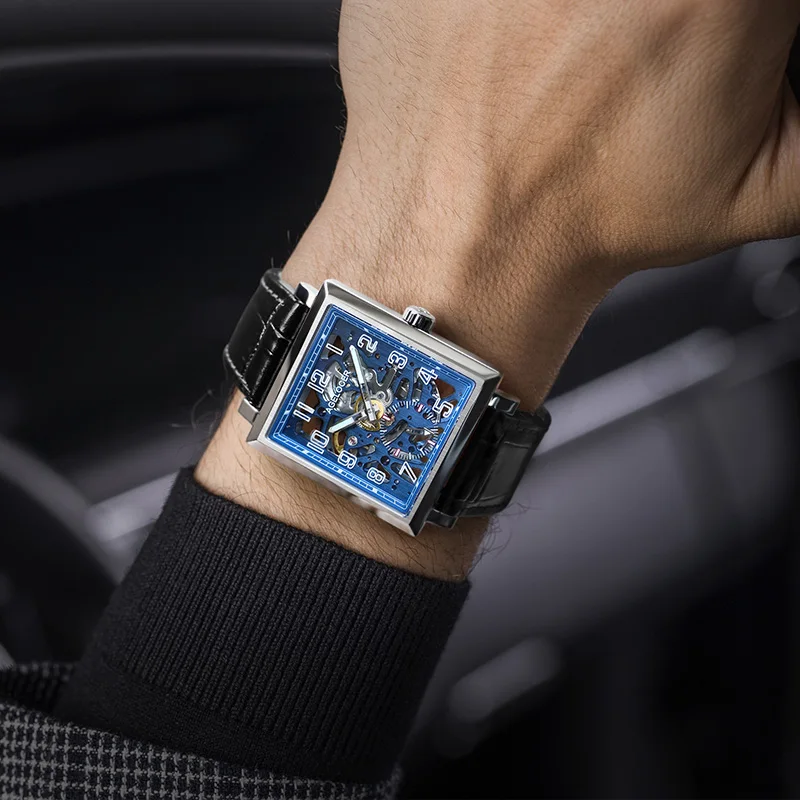
Materials and Construction: How They Enhance Each Style
The choice of materials significantly impacts how these transparent timepieces present themselves on the wrist. Case materials like stainless steel provide a neutral frame that puts focus on the movement, while gold adds warmth and luxury that complements the mechanical artistry.
Crystal selection plays a crucial role in the viewing experience. Sapphire crystal with anti-reflective coating offers the clearest view of the movement, minimizing glare and maximizing transparency. The superior scratch resistance of sapphire also ensures this visibility remains unmarred over years of wear.
For skeleton watches, movement finishing becomes particularly important as every surface is visible. Higher-end pieces feature extensive hand-finishing of components, while more accessible options may use mechanical processes to achieve decorative effects. The black skeleton watches in our collection demonstrate how color treatments can dramatically alter the character of these transparent timepieces.
Both durability and aesthetics benefit from thoughtful construction choices. The best examples balance the decorative removal of material with maintaining structural integrity—a delicate balance that defines quality in transparent watchmaking.
Which Watch Style Suits You? A Decision Guide
Selecting between open heart and skeleton watches ultimately comes down to your personal preferences and lifestyle needs. Consider these guiding questions:
How important is at-a-glance readability?
If you rely on quickly checking the time throughout your day, an open heart watch might better serve your needs with its clearer dial layout.
What’s your style personality?
Do you prefer subtle sophistication or bold statement pieces? Open heart watches offer mechanical interest with restraint, while skeleton designs make a more dramatic impression.
What’s your wearing occasion?
Consider when and where you’ll wear the watch. Open heart designs often transition more seamlessly between casual and formal settings, while skeleton watches may command more attention in professional environments.
How experienced are you with mechanical watches?
Open heart designs can serve as an excellent introduction to the mechanical watch world, offering a glimpse of the craftsmanship without the full complexity of a skeleton timepiece.
For those interested in exploring different case shapes that complement both styles, our square rectangular automatic watches offer distinctive options that pair well with either open heart or skeleton designs.
Movement Considerations: What Powers These Transparent Beauties
Both open heart and skeleton watches typically showcase mechanical movements—either manually wound or automatic—as these provide the visual dynamism that makes transparent designs compelling. Quartz movements, with their minimal moving parts, rarely feature in these styles since they lack the visual interest of mechanical calibers.
When the movement becomes a visual centerpiece, its quality and finishing become increasingly important. Higher-end transparent watches feature movements with decorative techniques like Geneva stripes, perlage (circular graining), and anglage (beveled edges). These finishing touches transform functional components into miniature works of art.
Some watchmakers develop movements specifically designed to be viewed, with architectural bridges and plates arranged for maximum visual impact. The longevity factors of automatic watches become particularly relevant when selecting a transparent timepiece, as the quality of the movement directly impacts both the visual experience and long-term reliability.
Styling and Occasions: When to Wear Each Type
Open heart watches often strike an ideal balance for business and smart-casual settings. Their partially intact dials maintain a certain formality while the mechanical window adds distinctive character without overwhelming. These watches pair particularly well with business attire, offering a subtle point of interest that complements rather than competes with your overall look.
Skeleton watches make their strongest impression in settings where distinctive accessories are appreciated. They become natural conversation pieces at social gatherings and can serve as the centerpiece of a carefully considered outfit. While traditionally associated with more casual or creative environments, modern skeleton designs with clean execution can also work in formal settings for those confident in their style choices.
For daily wear versatility, consider the extent of skeletonization and the overall color scheme. Watches with partial skeletonization or monochromatic color schemes typically offer greater versatility across different outfits and occasions.
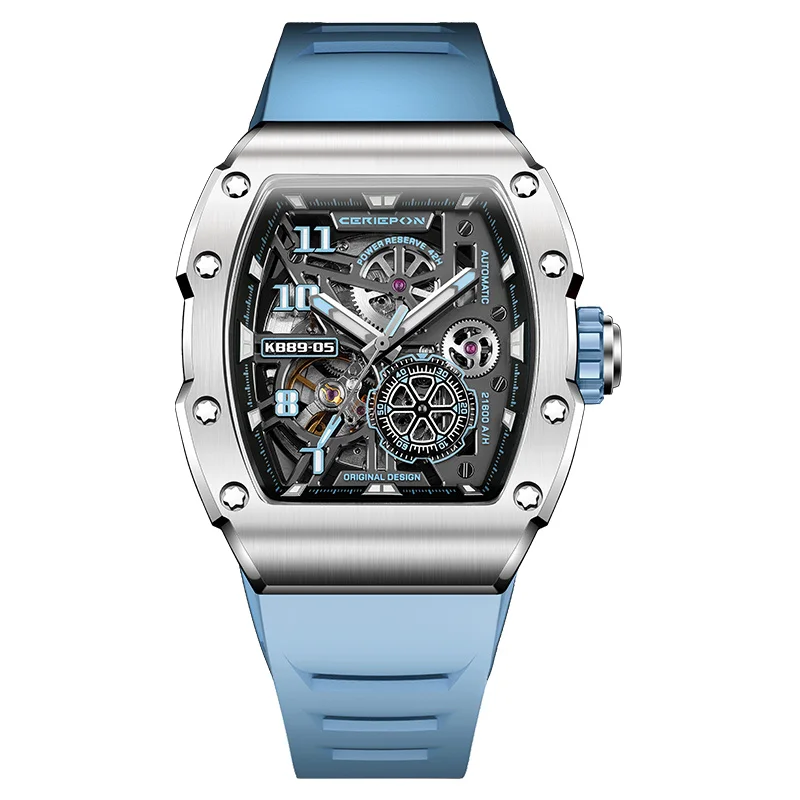
Automatic Skeleton Watches, Open Heart Automatic Watches
$98.36 Select options This product has multiple variants. The options may be chosen on the product pageBlack Skeleton Watches, Mechanical Skeleton Watches
Price range: $37.40 through $111.92 Select options This product has multiple variants. The options may be chosen on the product pageSquare & Rectangular Automatic Watches
Price range: $127.56 through $134.64 Select options This product has multiple variants. The options may be chosen on the product pageAutomatic Skeleton Watches, Mechanical Skeleton Watches
Price range: $166.16 through $169.76 Select options This product has multiple variants. The options may be chosen on the product pageAutomatic Skeleton Watches, Military Inspired Automatic Watches, Unique Automatic Watches
$191.88 Select options This product has multiple variants. The options may be chosen on the product pageAutomatic Skeleton Watches, Unique Automatic Watches
Price range: $1,718.05 through $1,749.20 Select options This product has multiple variants. The options may be chosen on the product page
Beyond the Dial: Additional Design Variations
The world of transparent watches extends beyond the simple binary of open heart versus skeleton designs. Semi-skeleton watches offer a middle ground, featuring multiple cutouts that show various movement parts while maintaining portions of a traditional dial for improved readability.
Double-sided transparency, achieved through both skeletonized movements and display casebacks, allows appreciation from all angles. This comprehensive approach transforms the watch into a truly three-dimensional object of horological art.
Modern interpretations have expanded the aesthetic possibilities with colorized movements, where bridges and plates receive PVD coatings or other treatments in vibrant hues that contrast with the mechanical components. Case shapes beyond the traditional round—including tonneau (barrel-shaped), rectangular, and asymmetric designs—can further complement the skeletal aesthetic.
The spectrum from minimalist to ornate approaches applies to both styles. Some watches feature clean, architectural skeletonization with a contemporary feel, while others embrace elaborate engraving and filigree work that references historical pocket watch traditions. The distinction between dress watches and everyday timepieces becomes interestingly blurred with transparent designs, which can serve either role depending on their execution.
Maintenance and Care: Keeping Your Transparent Timepiece Pristine
Watches that display their movements require special attention to maintain their visual appeal:
- Regular cleaning: Dust particles are more noticeable on exposed movements and can be particularly visible against dark components
- Proper cleaning technique: Use compressed air or a soft brush specifically designed for watches to gently remove dust without damaging delicate parts
- Professional servicing: Adhere to recommended service intervals (typically 3-5 years) to ensure both aesthetics and functionality
- Water consideration: Be especially mindful of water resistance limitations, as watches with more openings generally provide less protection against moisture
- Storage solution: When not wearing, store in a watch box or winder to minimize dust accumulation
The historical developments in water resistance innovations have improved durability for all watch styles, but transparent designs typically prioritize aesthetic considerations over extreme water resistance.
Are Open Heart and Skeleton Watches Durable?
Many watch enthusiasts wonder if the removal of material compromises the durability of transparent watches. Modern manufacturing techniques have largely addressed these concerns through careful engineering and material selection.
Despite their seemingly delicate appearance, quality skeleton watches maintain structural integrity through strategic design. The material is removed only from non-essential areas, while stress points receive reinforcement. The bridges and plates may be thinner but are designed to handle normal wearing conditions.
Shock resistance in better examples matches that of conventional watches, with movements featuring proper shock protection systems for the balance staff—the most vulnerable component.
Water resistance typically ranges from splash resistance to 30-50 meters, sufficient for everyday activities but not suitable for swimming or water sports. With proper care and reasonable precautions, both open heart and skeleton watches can be reliable daily companions for many years.
Frequently Asked Questions
Is an open heart watch the same as a skeleton watch?
No. An open heart watch has a small aperture showing primarily the balance wheel, while a skeleton watch removes extensive material to reveal most or all of the movement components.
Are skeleton watches harder to read?
Generally yes. The visual complexity of fully visible movements can make the hands less immediately distinguishable. Many designs address this with contrasting hand colors or partial dials.
What’s the difference between “openworked” and “skeleton”?
“Openworked” is the broader term encompassing any technique that creates visibility into the movement. “Skeleton” specifically refers to extensive material removal throughout the movement.
Which watch type is typically more expensive?
Fully skeletonized watches typically command higher prices due to the additional craftsmanship required for material removal and finishing of all visible components.
Are these watches suitable for everyday wear?
Yes, when properly constructed. Quality examples of both styles are designed for regular use, though they may require slightly more careful handling than solid-dial watches.
Do these watches require more maintenance?
They require the same mechanical servicing schedule but may benefit from more frequent external cleaning as dust is more visible on exposed components.
Can I see the movement from both sides?
Many skeleton and open heart watches feature transparent casebacks for viewing the movement from both sides, though some more affordable models may have solid casebacks.

